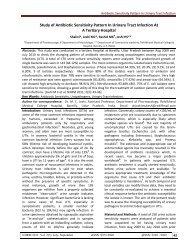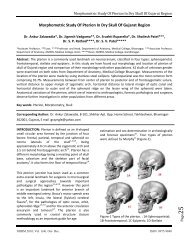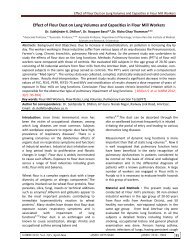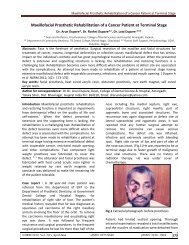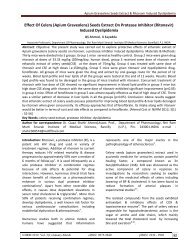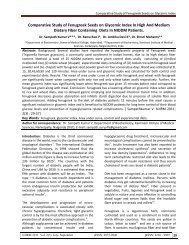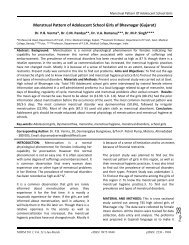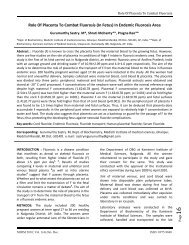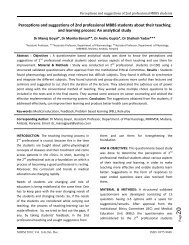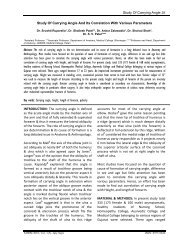Study Of Femoral Neck Anteversion 7 Study Of Femoral Neck ... - njirm
Study Of Femoral Neck Anteversion 7 Study Of Femoral Neck ... - njirm
Study Of Femoral Neck Anteversion 7 Study Of Femoral Neck ... - njirm
You also want an ePaper? Increase the reach of your titles
YUMPU automatically turns print PDFs into web optimized ePapers that Google loves.
femoral neck axis and the femoral condylar<br />
axis 10 . Hence estimation of anteversion on dry<br />
bone is still considered the most accurate<br />
method.<br />
There are few studies done in India before this<br />
study. Western studies results are not<br />
applicable in Indian population because<br />
femoral anteversion differs in both<br />
populations 11 .<br />
The mean anteversion in male bones was 7.2°<br />
and 14.3° on the left and right sides<br />
respectively averaging to about 10.9°. In<br />
females, it was 10.5° and 16.4° on the left and<br />
right side respectively averaging 13.6° in<br />
females. This significant bilateral limb<br />
asymmetry should discourage the tendency to<br />
view the lower limbs as mirror images of one<br />
Western<br />
studies<br />
Indian<br />
studies<br />
<strong>Study</strong> <strong>Of</strong> <strong>Femoral</strong> <strong>Neck</strong> <strong>Anteversion</strong> 10<br />
another. Statistical analysis revealed sexual<br />
dimorphism in anteversion (Table-1) in Indians<br />
being greater in the females as compared to<br />
males. A statistically significant difference was<br />
found for the angle of anteversion between the<br />
male-and female-type bones and the right- and<br />
left-sided bones. The average female-type bone<br />
was about 3° higher than the average maletype<br />
bone. Parsons et al 12 . had also<br />
documented anteversion to be greater in<br />
females. Similarly, Kingsley and Olmsted9<br />
observed a negligible difference (0.081°), and<br />
Yoshioka et al 8 . found a difference of 1° (Table-<br />
3). However, no tests of significance were done<br />
in these series. Kate BR et al 13 . done study on<br />
Indian femur found lesser average angle of<br />
anteversion as compared to present study<br />
(Table-3).<br />
Table-3 <strong>Femoral</strong> anteversion as observed by other researchers<br />
Researcher Sample Mean angle of anteversion in degree<br />
size Right Left Average<br />
Yoshioka Y et al 8 . (1987) 32 - - M-7 .F-8<br />
Kingsley PC et al 9 . (1948) 630 M-8.54, F-7.47 M-7.94, F-8.11 8.02<br />
Parsons FG et al 12 . (1914) 266 M-13.0, F-18.0 M-13.0, F-16.0 15.3<br />
Kate BR et al 13 . (1976) 108 9.0 8.6 8.8<br />
Present study (2005) 92 M-7.2, F-10.5 M-14.3, F-16.4 12.4<br />
Because Indians are more apt to participate in<br />
floor level activities, in contrast to persons in<br />
the West, our hips have to be evolutionally<br />
different from theirs. Thus, the same procedure<br />
produces a different outcome in our<br />
population. Hence a population-specific<br />
protocol and assessment criteria must be<br />
devised. A femoral component of a total hip<br />
replacement should be in an anteversion angle<br />
that closely represents the anteversion angle<br />
for the Indian population to achieve the best<br />
surgical results. In India with the increasing<br />
demand for total hip replacement, this<br />
anteversion angle becomes more significant.<br />
Therefore, our study was undertaken to<br />
ascertain the average angle of anteversion of<br />
the femoral neck in Indian subjects.<br />
CONCLUSIONS: The average angle of<br />
anteversion obtained on dry bone was 12.4°<br />
NJIRM 2010; Vol. 1(3). July-Sept. ISSN: 0975-9840



